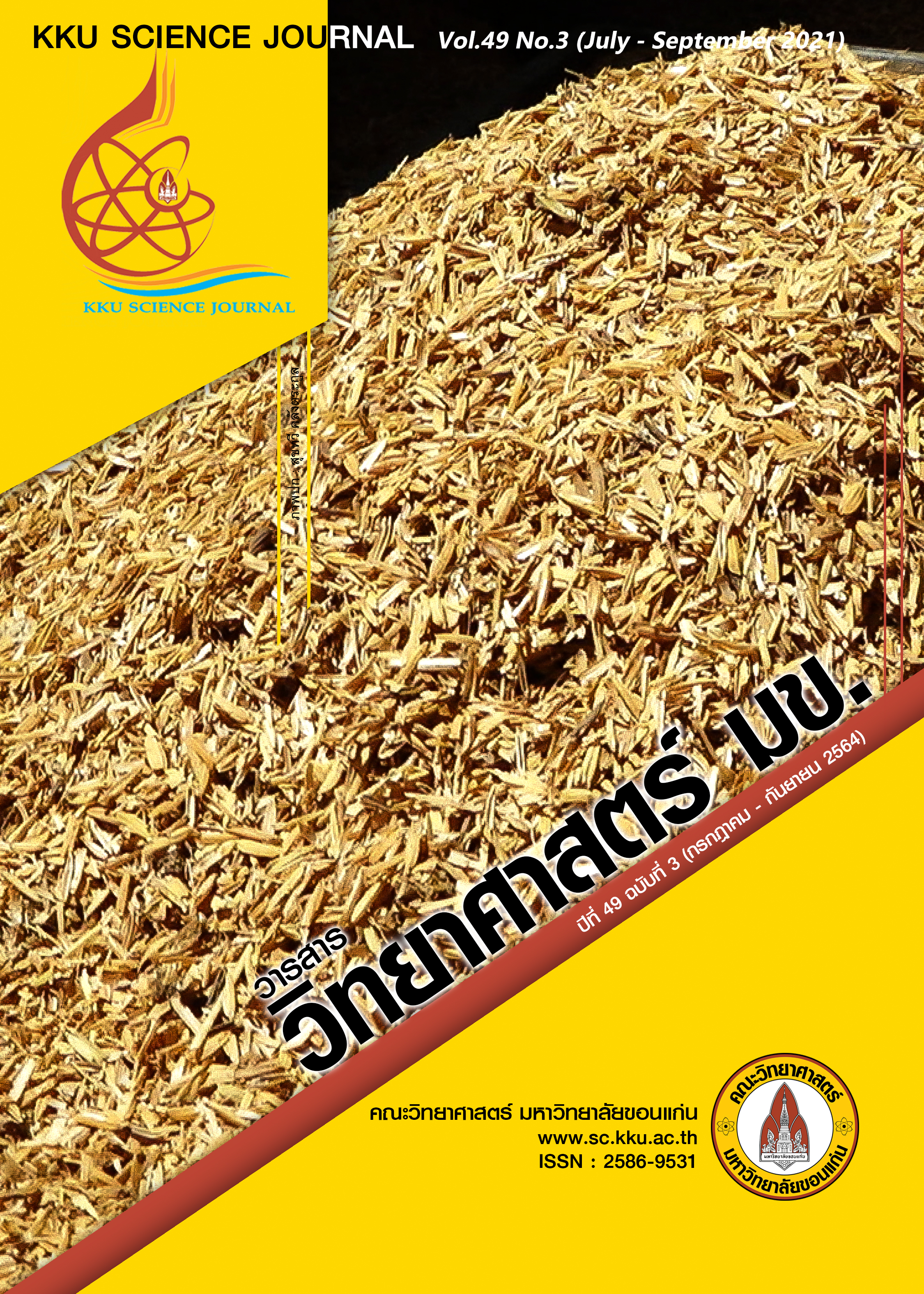Fabrication of the Nonwoven Polypropylene Fibers from the Melt-Blown Machine for Oil Absorption Application
Main Article Content
Abstract
In this research, a melt-blowing machine was built to produce nonwoven polypropylene fibers for oil absorption. The effect of nozzle temperatures (170, 190, 210, and 230 °C) on fiber characteristics and contact angles of nonwoven polypropylene fibers were studied. The oil absorption capacity of nonwoven polypropylene fibers was tested using ASTM-F726-12 standard method. The maximum oil absorbency was measured after 3 s of oil absorption. The result shows that the maximum oil absorption decreases as the nozzle temperature increases. The oil adsorption values were 20.78±1.46 19.40±1.26 16.34±0.48 and 11.57±2.53 (g/g) when the nozzle temperatures were 170, 190, 210, and 230 °C, respectively. The melting temperature connects fibers to the surrounding fibers, making the fibers larger and some will clump together, reducing gaps between the fibers, and the contact surface area of the nonwoven fiber sheet is reduced with increasing the nozzle temperatures. The results of the oil absorption test at 10-60 min showed a non-linear decrease. The nonwoven polypropylene fibers prepared at a nozzle temperature of 170 °C have the best oil absorbency because they have uniform fiber cohesion characteristics and higher hydrophobic properties than other samples.
Article Details

This work is licensed under a Creative Commons Attribution-NonCommercial-NoDerivatives 4.0 International License.
References
Abdullah, M. A., Rahmah, A .U. and Man, Z. (2010). Physicochemical and sorption characteristics of
Malaysian ceiba pentandra (L.) gaertn. As a natural oil sorbent. Journal of Hazardous Materials 177(1-3): 683-691.
Al-Majed, A. A., Adebayo, A. R. and Hossain, M. E. (2012). A sustainable approach to controlling oil spills. Journal of Environmental Management 113: 213-227.
Bazargan, A., Sadeghi, H., Garcia-Mayoral, R. and Mckay, G. (2015). An unsteady state retention model for fluid desorption from sorbents. Journal of Colloid and Interface Science 450: 127-134.
Carmody, O., Frost, R., Xi, Y. and Kokot, S. (2008). Selected adsorbent materials for oil-spill cleanup a thermoanalytical study. Journal of Thermal Analysis and Calorimetry 91(3): 809-816.
Cortese, B., Caschera, D., Federici, F. Ingoc, G. M. and Gigli, G. (2014) Superhydrophobic fabrics for oil-water Separation through a diamond like Carbon (DLC) coating. Journal of Materials Chemistry A 2(19): 6781-6789.
Khan, E., Virojnagud, W. and Ratpukdi, T. (2004). Use of biomass sorbents for oil removal from gas station run off. Chemosphere 57(7): 681-689.
Lim, T. T. and Huang, X. (2006) In situ oil/water separation using hydrophobic-oleophilic fibrous wall: a lab-scale feasibility study for groundwater cleanup. Journal of Hazardous Materials 137(2): 820-826.
Li, H., Wu, W., Bubakir, M. M., Hongbo, C., Zhong, X., Liu, Z., Ding, Y. and Yang, W. (2013) Polypropylene fibers fabricated via a needleless melt-electrospinning device for marine oil-spill cleanup. Journal of Applied Polymer Science 131(7): 40080.
Nyankson, E., Rodene, D. and Gupta, R. B., (2015). Advancements in crude oil spill remediation research after the deep water horizon oil spill. Water Air and Soil Pollution 227(1): 29.
Seddighi, M., Charkhabi, A. H. and Tajik, M. (2011). Water-oil separation performance of technical textiles used for marine pollution disasters. Marine Pollution Bulletin 96(1–2): 286-293.
Senanurakwarkul, C. and Chavarnakul, T. (2012). The study of factors influencing the decision to select the use of oil sorbent in Thailand. International Journal of Research in Management and Technology 2(6): 603-607.
Singh, V., Jinka, S., Hake, K., Parameswaran, S., Kendall, R. J. and Ramkumar, S. (2014). Noval Natural Sorbent for oil Spill Cleanup. Industrial and Engineering Chemistry Research 53: 11954-11961.
Teas, Ch., Kalligeros, S., Zanikos, F., Stournas, S., Lois, E. and Anastopoulos, G. (2001) Investigation of the effectiveness of absorbent material in oil spills clean up. Desalination. 140: 259-264.
Wei, Q. F., Mather, R. R., Fotheringham, A. F. and Yang, R. D. (2003). Evolution of polypropylene nonwoven oil sorbents in marine oil spill recovery. Marine Pollution Bulletin 46(6):780-783.
Zahid, M. A., Halligan, J. E. and Johnson, R. F. (1972). Oil Slick Removal Using Matrices of Polypropylene Filaments. Industrial and Engineering Chemistry, Process Design and Development 11(4): 550-555.
Zhao, J., Xiao, C. and Xu, N. (2013). Evaluation of polypropylene and poly (butylmethacrylate-co-hydroxyethyl methacrylate) nonwoven material as oil absorbent. Environmental Science and Pollution Research 20(6): 4137-4145.


